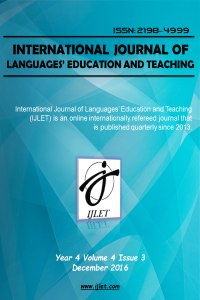Öz
Poem Appreciation is a compulsary course at Indonesian Language and Literature Education Department of higher education. This exploratory research aimed at exploring problems and needs encountered by lecturers and students in Poem Appreciation course in the areas of Surakarta ex-residency and Yogyakarta Special Region. The research subjects were lecturers and students involved in poem learning in those areas. Observation, interview, document analysis, and questionnaire were used as data collection techniques. Related to Poem Appreciation course, the problems and needs for lecturers are: (1) the arrangement of lesson plan and syllabus; (2) the implementation of its procedure; (3) the evaluation of its learning; whereas those for students include the use of strategy and learning models which are innovative, effective, and students-centered. Inquiry-Based Learning (IBL) is necessarily needed by lecturers and students in Poem Appreciation course.
Anahtar Kelimeler
Kaynakça
- Ministry of Research, Technology, and Higher Education. Indonesian Qualification Framework. (2015). Retrieved in August 2015 from http://kkni-kemenristekdikti.org/asset/pdf/001-dokumen_kkni.pdf. Mulyana, Yoyo. (2001). Pembelajaran Makna Puisi dengan menggunakan Model Mengajar Respons Pembaca in Mimbar Pendidikan Year XX, Number 4. Nurgiyantoro, Burhan. (2010). Penilaian Pembelajaran Bahasa. Yogyakarta: BPFE. Sudjana, Nana. (2004). Dasar-Dasar Proses Belajar Mengajar. Bandung: Remaja Sinar Baru Algensindo.
Öz
Kaynakça
- Ministry of Research, Technology, and Higher Education. Indonesian Qualification Framework. (2015). Retrieved in August 2015 from http://kkni-kemenristekdikti.org/asset/pdf/001-dokumen_kkni.pdf. Mulyana, Yoyo. (2001). Pembelajaran Makna Puisi dengan menggunakan Model Mengajar Respons Pembaca in Mimbar Pendidikan Year XX, Number 4. Nurgiyantoro, Burhan. (2010). Penilaian Pembelajaran Bahasa. Yogyakarta: BPFE. Sudjana, Nana. (2004). Dasar-Dasar Proses Belajar Mengajar. Bandung: Remaja Sinar Baru Algensindo.
Ayrıntılar
| Birincil Dil | İngilizce |
|---|---|
| Konular | Dil Çalışmaları (Diğer) |
| Bölüm | Araştırma Makalesi |
| Yazarlar | |
| Yayımlanma Tarihi | 30 Aralık 2016 |
| Yayımlandığı Sayı | Yıl 2016 Cilt: 4 Sayı: 3 |


